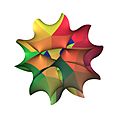Calabi-Yau manifold facts for kids
A Calabi–Yau manifold is a special kind of shape or space used in advanced mathematics. Think of it as a very complex, curved surface, but in many more dimensions than we can easily imagine.
These shapes are important in a part of math called algebraic geometry. They also have big uses in theoretical physics, especially in something called superstring theory. Scientists believe that the tiny extra dimensions of spacetime (the fabric of our universe) might be shaped like a 6-dimensional Calabi–Yau manifold. This idea helped create the concept of string theory mirror symmetry, which is like finding two different-looking Calabi–Yau shapes that are actually mathematically the same.
Contents
What is a Manifold?
A manifold is a mathematical space that looks like flat Euclidean space when you zoom in very close. Imagine the surface of the Earth. If you look at a small patch, it seems flat, even though the Earth is a sphere. A manifold is a more general idea of this, but it can have many more dimensions.
Dimensions in Calabi–Yau Spaces
When we talk about a Calabi–Yau manifold, we often mean a 6-dimensional shape. This is hard to picture because we usually only think in three dimensions (length, width, height). These extra dimensions are thought to be very tiny and curled up, so we don't notice them in our everyday lives.
Calabi–Yau and String Theory
String theory is a big idea in physics that tries to explain everything in the universe. It suggests that the basic building blocks of the universe are not tiny particles, but incredibly small vibrating strings.
Extra Dimensions in the Universe
For string theory to work, it needs more than our usual four dimensions (three space dimensions and one time dimension). It needs six extra dimensions that are curled up very tightly. Scientists believe these extra dimensions could be shaped like a Calabi–Yau manifold.
Mirror Symmetry Explained
One cool idea from studying Calabi–Yau manifolds in string theory is called "mirror symmetry." It means that two different Calabi–Yau shapes, which look very different, can actually lead to the exact same physics. It's like having two different maps that describe the same journey perfectly. This has helped physicists and mathematicians learn a lot about these complex shapes.
Images for kids
See also
 In Spanish: Variedad de Calabi-Yau para niños
In Spanish: Variedad de Calabi-Yau para niños



